Abstract
Background
Difficult airway management (DAM) presents a complex array of challenges inherent in establishing and maintaining a patient’s airway during medical procedures or emergencies. Consequences of compromised DAM are profound, ranging from hypoxia, and aspiration, to cardiac arrest. Despite the ongoing progress and innovation in airway management, DAM remains a significant clinical challenge. Performing a bibliometric analysis of the most cited articles in this domain offers quantitative and qualitative insights into the landscape and trend of key research; our analysis revealed an increasing focus on video laryngoscopy research over the past decade, with a notable surge in studies related to airway management during infectious disease outbreaks in recent years.
Methods
We performed a bibliometric analysis of the 100 most-cited articles on DAM (Top100DAM) published between 2011 and 2022, sourced from both PubMed and Web of Science databases. Employing social network analysis, we identified key associated topics and cluster terms. Cluster terms are broad categories encompassing related topic terms. Topic terms are specific keywords or phrases found in the articles. Citation counts were estimated for each article, and cluster-specific reviews were generated using the Medical Query Expert software.
Results
The Top100DAM comprised 53 topic terms spanning 11 cluster terms. “Anesthesiology” stood out as the most frequently featured cluster, and “betacoronavirus” had the highest Impact Factor. There was a significant correlation between the counts between the inferred citation based on cluster terms and the observed citation (Pearson’s R = 0.06,
Conclusion
DAM plays a central role in anesthesiology research, with a significant emphasis on guideline development, technological advancements like video laryngoscopy, and adapting practices for infectious disease scenarios. The increased publication volume and high citation rates during the COVID-19 pandemic underscore how ongoing research and innovation have accelerated, refining DAM practices. Articles with high citation rates mostly pertain to guidelines, illustrating their substantial impact on clinical practice and the necessity for studies to base their discussions on these guidelines. Future research should focus on addressing the implementation challenges of existing guidelines and developing context-specific protocols for diverse clinical settings.
Keywords
bibliometrics, difficult airway management, natural language processing
Introduction
Difficult airway management (DAM) is defined as “the clinical situation in which a conventionally trained anesthesiologist experiences difficulty with facemask ventilation (the process of providing oxygen to a patient using a mask covering the nose and mouth) of the upper airway, difficulty with tracheal intubation (the insertion of a tube into the windpipe to maintain an open airway), or both.1 Challenging laryngoscopy (the procedure of examining the larynx or voice box) arises when conventional techniques fail to visualize any part of the vocal cords, despite multiple attempts. Complex tracheal intubation is marked by the difficulty of successfully inserting a tracheal tube or even supraglottic airways (devices placed above the vocal cords to maintain an open airway), requiring repeated efforts, irrespective of the presence or absence of tracheal pathology. In instances where the placement of the endotracheal tube proves unsuccessful after multiple attempts, clinicians may label it as “failed intubation”.
Anatomical challenges contributing to DAM include factors such as a small mouth, large tongue, prominent upper teeth, short neck, and limited jaw mobility, which can potentially compromise intubation and ventilation. Pathologic conditions including obesity, facial or neck trauma, upper airway edema, neck mass and tumors, infections, burns, a history of head and neck or airway surgeries, temporomandibular joint disorders, or structural airway abnormalities leading to crowded airway, limited mouth opening, scars, and altered anatomy further complicate the airway management.2 In addition, physiological factors must be taken into account in the intubation plan, even in the absence of apparent anatomical concerns. These typically include hypoxemia, hypotension, severe metabolic acidosis, and right ventricular failure,3 which inherently increase the patient’s risk of cardiovascular collapse during intubation and the transition to positive pressure ventilation. Understanding and addressing anatomical and physiological complexities is essential for comprehensive and successful airway management.
Recent advancements in DAM include the widespread adoption of video laryngoscopy, refinement of extubation strategies, and the development of cognitive aids for crisis management. Studies by the Intensive Care Society State of the Art4 in 2022 and Yang et al.5 in 2022 have highlighted the impact of these innovations on patient outcomes. Our analysis aims to contextualize these recent developments within the broader landscape of DAM research over the past decade.
The result of a failed airway has a profound impact on patient outcomes. Managing difficult airways involves quick decision-making, resource utilization, and a team approach due to diverse underlying conditions. As techniques and innovative ways evolve, education and training are critical in establishing and maintaining competency in DAM. Staying abreast of evidence-based practices improves the knowledge, technical and procedural approaches, and system processes to reduce complications and ensure patient safety.
We conducted a bibliometric analysis of the top-cited articles to elucidate insights into their scholarly impact and contributing influences on clinical practice and research trends. Our primary objectives are to identify the most influential articles and authors in DAM research, analyze the impact of recent technological innovations such as video laryngoscopy and cognitive aids on patient outcomes, and map the evolution of DAM research over the past decade.
By combining quantitative bibliometric analysis with qualitative reviews and using natural language processing (NLP) techniques, our study aims to provide a comprehensive understanding of advancements and trends within the DAM research landscape. By combining quantitative bibliometric analysis with qualitative reviews and using NLP techniques, our study aims to provide a comprehensive understanding of advancements and trends within the DAM research landscape. We conducted a bibliometric analysis of the top-cited articles to gain insights into the countries, journals, and research topics influencing DAM, and explored the correlation between research topics and citation counts, illustrating their characteristics using Sankey diagrams. This approach allows us to assess research trends, identify influential works and authors, and map the evolution of the field over time. By examining citation patterns and clustering research topics, we aim to provide insights into the current state of DAM research, elucidating shifts in research focus, the impact of technological innovations, and the adoption of new guidelines, thereby identifying potential areas for future investigation.
Methods
Top 100 Cited Articles Related to DAM
We gathered data from the PubMed database using the keywords “difficult airway management”, resulting in 1,486 articles retrieved. Within the Web of Science (WOS) database, the top 100 articles (Top100DAM), authors’ countries, and topic termswere selected based on the “Times Cited, WOS Core”, “Addresses”, and “Research Areas” columns, respectively. In cases where authors are from multiple countries, the nationality of the first author was considered. The major MeSH terms (Medical Subject Headings, a comprehensive controlled vocabulary for indexing journal articles and books in the life sciences) from the Entrez database were extracted using the Python package “biopython”. The MeSH Qualifier subheadings were not included in this analysis.
Bibliometrics Used to Evaluate the Citations of an Article
We utilized three commonly used metrics, including Impact Factor (IF, a measure of the frequency with which the average article in a journal has been cited in a particular year), H-index (a metric that attempts to measure both the productivity and impact of a researcher), and H-index for Time (Ht-index, an extension of H-index that takes into account the age of publications). The IF quantifies the average citation count garnered by articles associated with a specific entity, such as a particular journal, country, or, in our context, a specific topic. H-index takes into account both the number of publications and their citation counts. An entity’s H-index is the highest number of the articles that have received at least that many citations. Ht-index is an extension of H-index that takes into consideration the temporal aspect of an entity’s work. It reflects how an entity’s impact evolves over time, accounting for the fact that older publications may have had more time to accumulate citations. This metric provides a dynamic view of an entity’s influence, taking into account their recent contributions and their lasting impact from earlier work.
Cluster Terms
Topic terms, which encompassed both WOS research areas and major MeSH terms, were organized through social network analysis facilitated by the Python tool NetworkX. Within this network, the edge weights corresponded to the frequency of co-occurrence of two topic terms within the same articles, while individual nodes represented each topic term. Visualization of the network was achieved using the Fruchterman-Reingold force-directed technique.6,7
To further group these topic terms into cluster terms, we employed the Louvain community discovery algorithm,8 a widely-used method for identifying communities or clusters in large networks based on modularity optimization. This algorithm efficiently uncovers hierarchical community structures by iteratively maximizing modularity at different scales. A resolution of 2 and a threshold of 1e-07 were applied in this process. Each cluster term was represented by the most frequently occurring topic term, simplifying analysis by aggregating related topic terms.
Cluster terms were chosen based on their frequency and co-occurrence within the analyzed articles. For example, terms like “vlaryngeal masks” and “practice guidelines as topic” were frequently found together and thus clustered under the broader term “anesthesiology”. This clustering approach allows us to identify overarching themes in the research landscape and their relationships to our study objectives of mapping key areas of focus in DAM research. The relevance of these cluster terms to our findings is demonstrated in the network analysis visualizations and citation impact assessments presented in the Results section.9
Inferring the Citation Counts According to Topic Terms or Cluster Terms
First, we calculated the citation counts for each cluster term. An article was assigned to a specific cluster term if any of its topic terms fell within that cluster. Given that a single article might encompass several topic terms spanning various cluster terms, it could potentially be affiliated with multiple cluster terms. Subsequently, the citation counts on a given cluster term were computed as the aggregate of all citation counts associated with the articles that had been assigned to that particular cluster.
Prior research has put forth a method involving the computation of weighted citation numbers associated with individual topic terms or cluster terms.9 First, we determined the weighted count for each topic termor cluster terms. The weighted count of a specific was represented as, and its calculation followed the formula (1: calculates the weighted frequency of a topic term within an article.). Here,
Subsequently, we computed the weighted citations associated with a topic term, demoted as, following the formula (2: computes the weighted citations for a topic term across all articles.).
Here, the weighted count of each
The average number of citations for a topic term, denoted as, can be obtained using formula (3: determines the average number of citations for a topic term.), where
Finally, we can estimate the citation count of an
Statistical Analysis
We used linear regression to examine the relationship between predicted and actual citation counts. This statistical technique helps us understand how well our model estimates citations based on cluster terms. The
Medical Query Expert Software
The Medical Query Expert (MQE) (Software v0.0.4, Muen Biomedical and Optoelectronic Technologist, Inc., Taipei City, Taiwan) follows a three-step process to generate results. First, it retrieves article abstracts from the PubMed database using user-defined keywords. Second, the users can input a question, and the MQE Software employs NLP algorithms to extract pertinent sentences from the abstracts that provide answers to the question. Third, a summary paragraph is generated using NLP model.
Results
Descriptive Statistics of Top100 Cited Articles Related to DAM
The US, England, and Canada are the top 3 contributors (Table 1). For the US, the country contributed a total of 32 papers in 10 years with a total of 3,534 citations, an average IF of 110.44, an H-index of 32, and an Ht-index of 45.89. For England, the country contributed a total of 21 papers in 10 years with a total of 4,634 citations, an average IF of 220.67, a H-index of 21, and an Ht-index of 41.25. For Canada, the country contributed a total of 10 papers in 10 years with a total of 865 citations, an average IF of 86.50, an H-index of 10, and an Ht-index of 19.97. They contributed nearly two-thirds of the Top100DAM at a total of 63 papers. Although the USA contributed the most papers, England has the highest citation at 4,636 and an average IF of 220.67. Interestingly, although only 5 papers, Denmark’s average IF is higher than usual, placing third overall, coming in at 102.20.
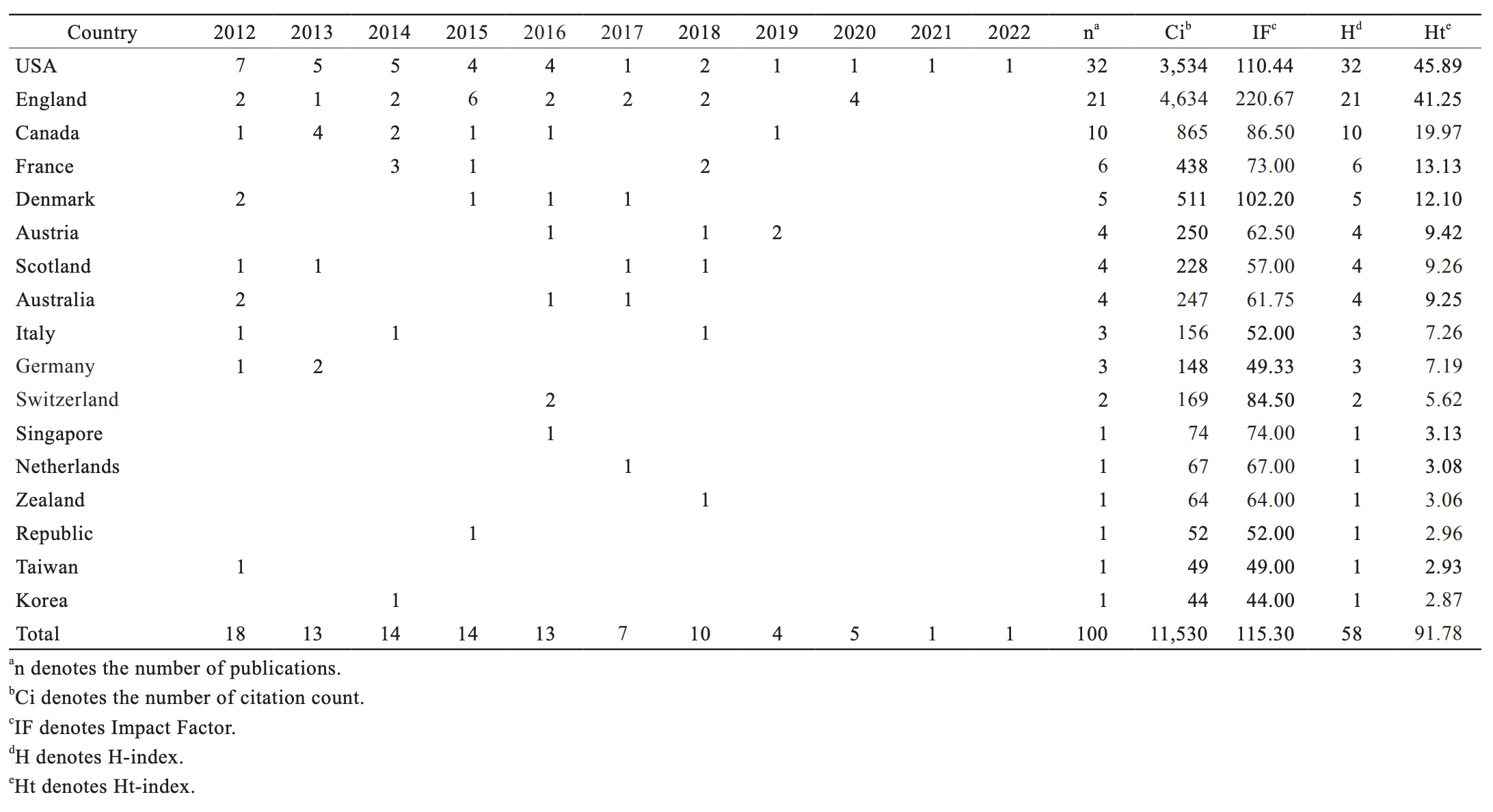
Download full-size image
Table 2 summarizes the publication and citation counts for journals of Top100 DAM.

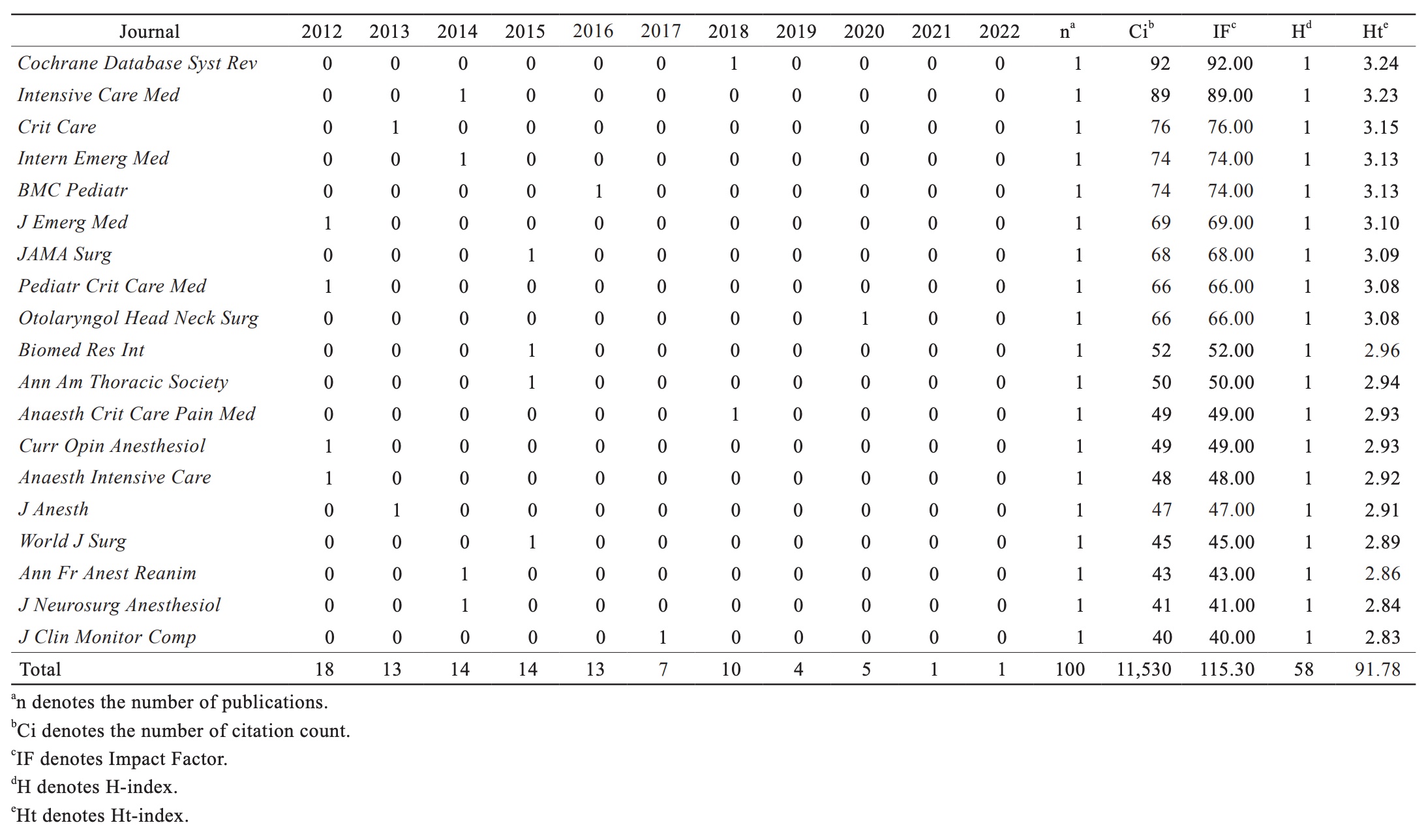
Download full-size image
The Result of Social Network Analysis of Top100 Cited Articles Related to DAM
We collected a total of 10 WOS terms and 43 mesh terms (Table A1 in Appendix). After clustering, the collected terms were grouped into 11 cluster terms (Figure 1), including anesthesiology, general & internal medicine, laryngoscopes, pediatrics, intensive care units, surgery, fiber optic technology, betacoronavirus, airway management, interdisciplinary communication, and patient safety. “anesthesiology”, “general & internal medicine”, and “laryngoscopes” are the most commonly occurring cluster terms (Figure 1 and Table 3). These terms were mentioned in 78, 23, and 11 articles, respectively. In the same order, they occur with frequencies of 100, 35, and 19. All the terms above frequently appear together, with a notable association with “anesthesiology” and other supporting terms such as “intensive care units” and “pediatrics”. Another interesting result is the appearance of betacoronavirus in the graph, showing the impacts of the pandemic to the field of research of DAM in anesthesiology.
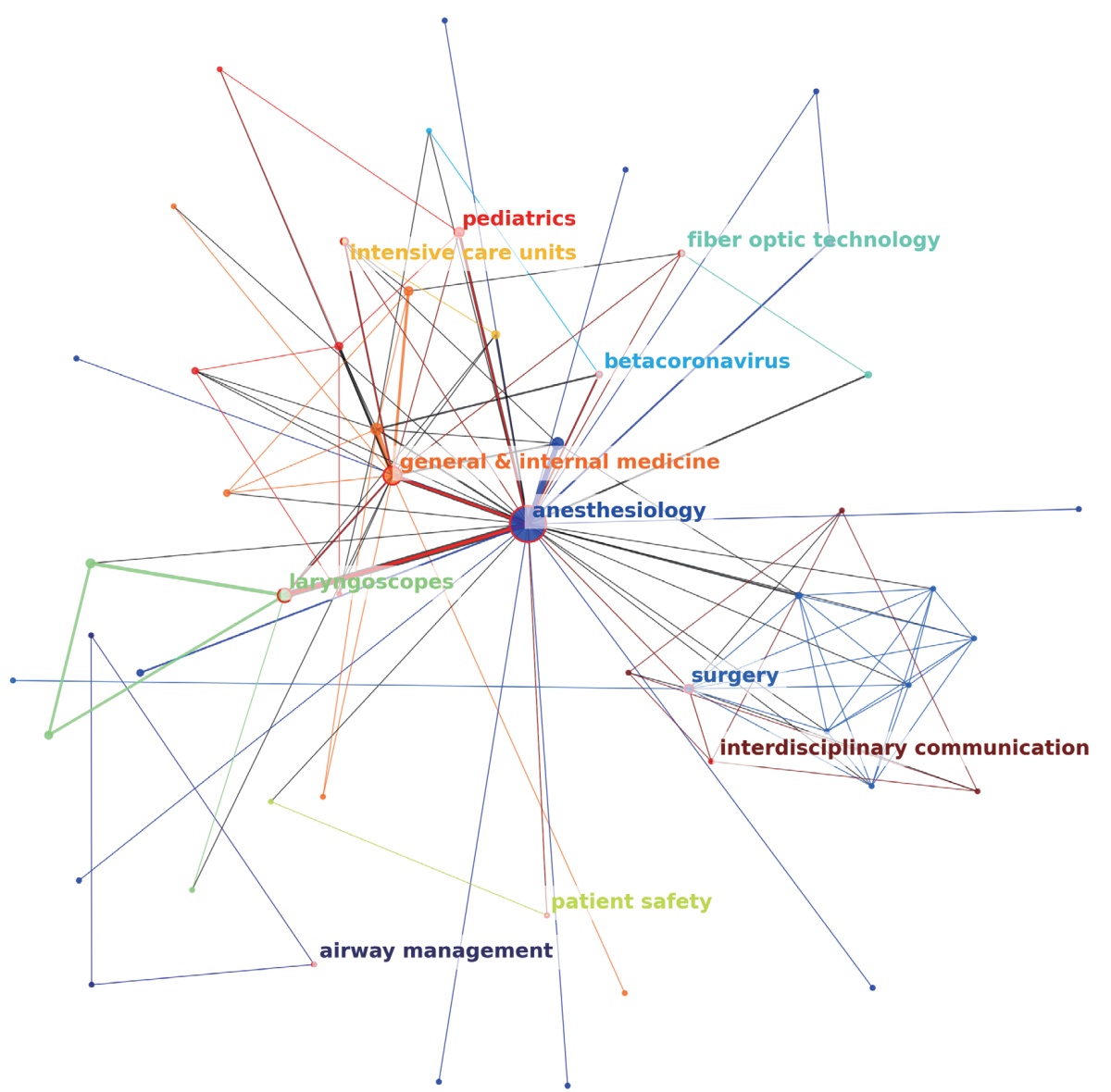
Download full-size image
In the network illustration, each node corresponded to a topic term, and the size of each node indicated its frequency of appearance within the Top100DAM. The width of the connecting lines, or edges, between nodes depicted the frequency of occurring together between two topic terms. Node colors were indicative of their respective cluster term. Within the network, 11 specific cluster terms were chosen to represent each cluster term, and the edges connecting them were colored in red. For all other edges, the color matched the node color if the linked nodes belonged to the same cluster term; otherwise, they were displayed in black.
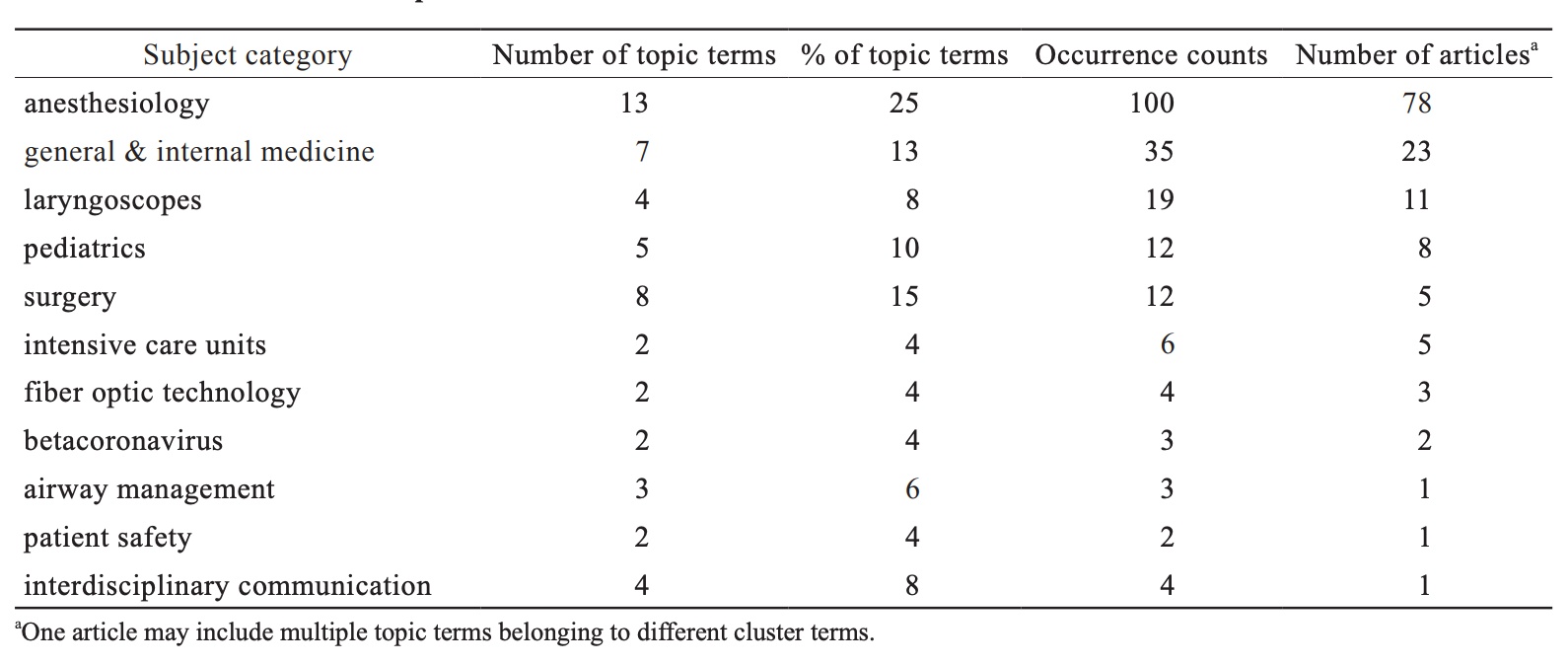
Download full-size image
Article Citation Counts and Their Corresponding Cluster Term
The citation counts of Top100DAM and their corresponding cluster terms are illustrated in Figure A1 in Appendix. The majority of highly-cited articles carried the cluster term “anesthesiology”, and the figure also highlighted the frequent appearance of other terms like “general & internal medicine”, “laryngoscopes”, and “pediatrics”. To construct a more concise visualization, we further selected the top 30 most-cited articles related to DAM (Top30DAM) and illustrated the network again (Figure 2). Six cluster terms appeared in Top30DAM: anesthesiology, betacoronavirus, laryngoscopes, intensive care units, general & internal medicine, and pediatrics. These terms were consistent with the findings in Top100DAM, “anesthesiology”, “general & internal medicine”, “laryngoscopes”, and “pediatrics”. Notably, in Top30DAM, the additional frequent cluster term, “betacoronavirus”, was associated with only 2 articles but garnered a high number of citations.
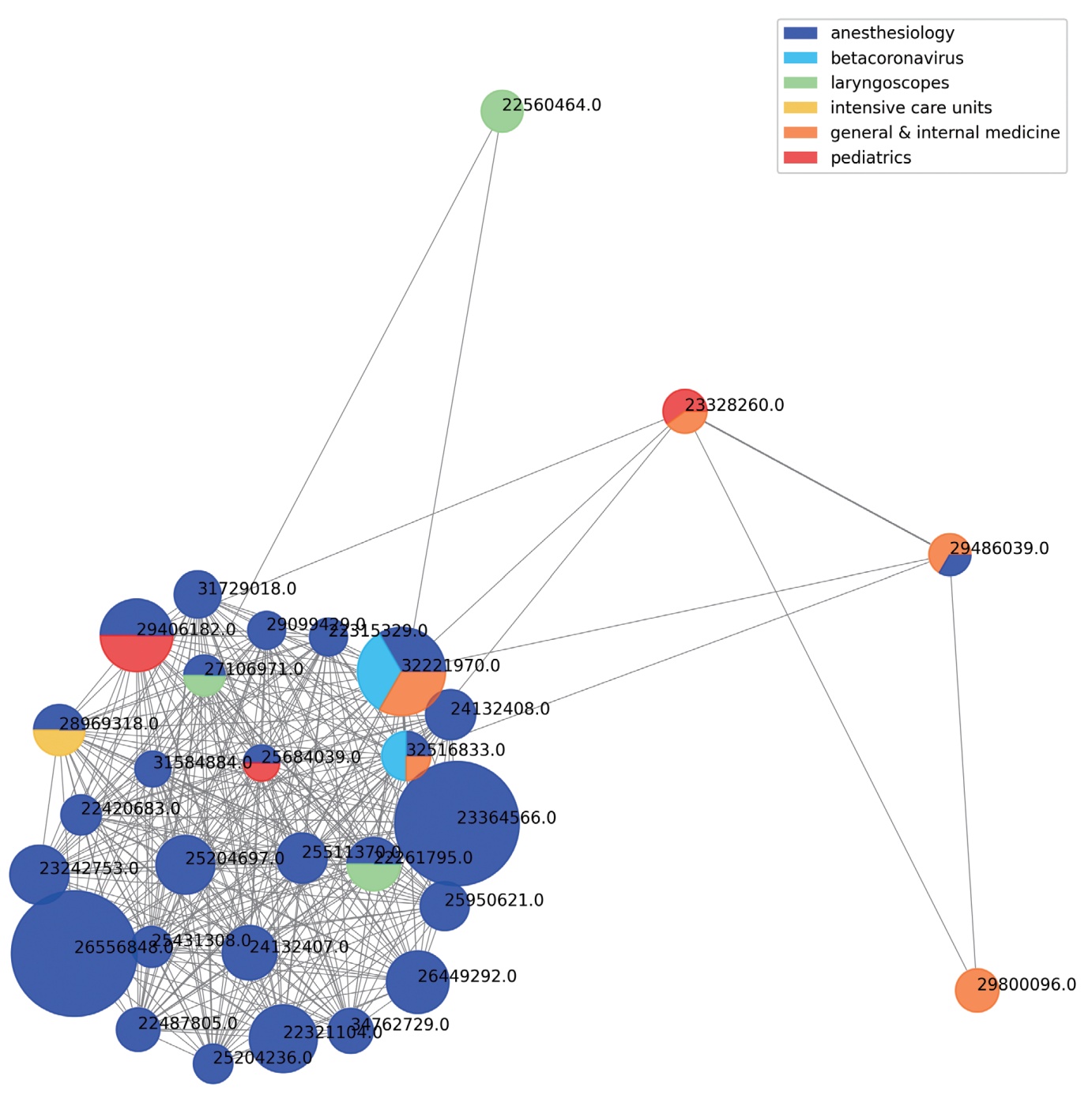
Download full-size image
In the network, every node represented an article, and the size of each node indicated the number of citations it received. The thickness of the edges between nodes symbolized the presence of shared topic terms. The colors, presented in a pie-chart-like manner, were employed to visually represent the proportion of each cluster term.
Citation Counts of Cluster Term Within Top100DAM
Figure 3 illustrates the citation counts for each cluster term within the Top100DAM. The cluster term “anesthesiology” stood out with the highest number of articles (n = 78) and total citation counts (Ci = 9,969), and it came in second in IF score at 127.8. On the contrary, “betacoronavirus” has the highest IF score of 372, almost triple that of “anesthesiology”, but it is only associated with only 2 articles. This was attributed to the surge of research attention drawn by the outbreak of coronavirus disease 2019 (COVID-19) in recent years, leading to increased citation counts. “Pediatrics” is another distinctive cluster term. It gathered a total of 907 citations, stemming from just 8 articles and resulting in a high IF score of 113.4. This suggested that, despite the relatively lower number of Top100DAM specific to the field of pediatrics, it has amassed significant attention and a substantial number of citations.
Concerning MeSH terms (Figure A2 in Appendix), “laryngoscopes” emerges as the most frequent term within Top100DAM, despite not having the highest IF score (IF = 81.0). Conversely, three MeSH terms exhibited exceptional IF scores but a limited number of articles (n = 2). These terms include “practice guidelines as topic”, “betacoronavirus”, and “critical illness”. This outcome was attributed to a small number of papers receiving exceptionally high citation counts, particularly in the case of guidelines. Regarding WOS research areas (Figure A3 in Appendix), the distribution of IF scores appears to be more balanced when compared to cluster terms and MeSH terms. Among them, “anesthesiology” is both the most frequent term (n = 77) and the highest IF score (IF = 127.8). Another prominent term of research areas is “emergency medicine”, which has the IF score of 80.3 associated with 3 articles.
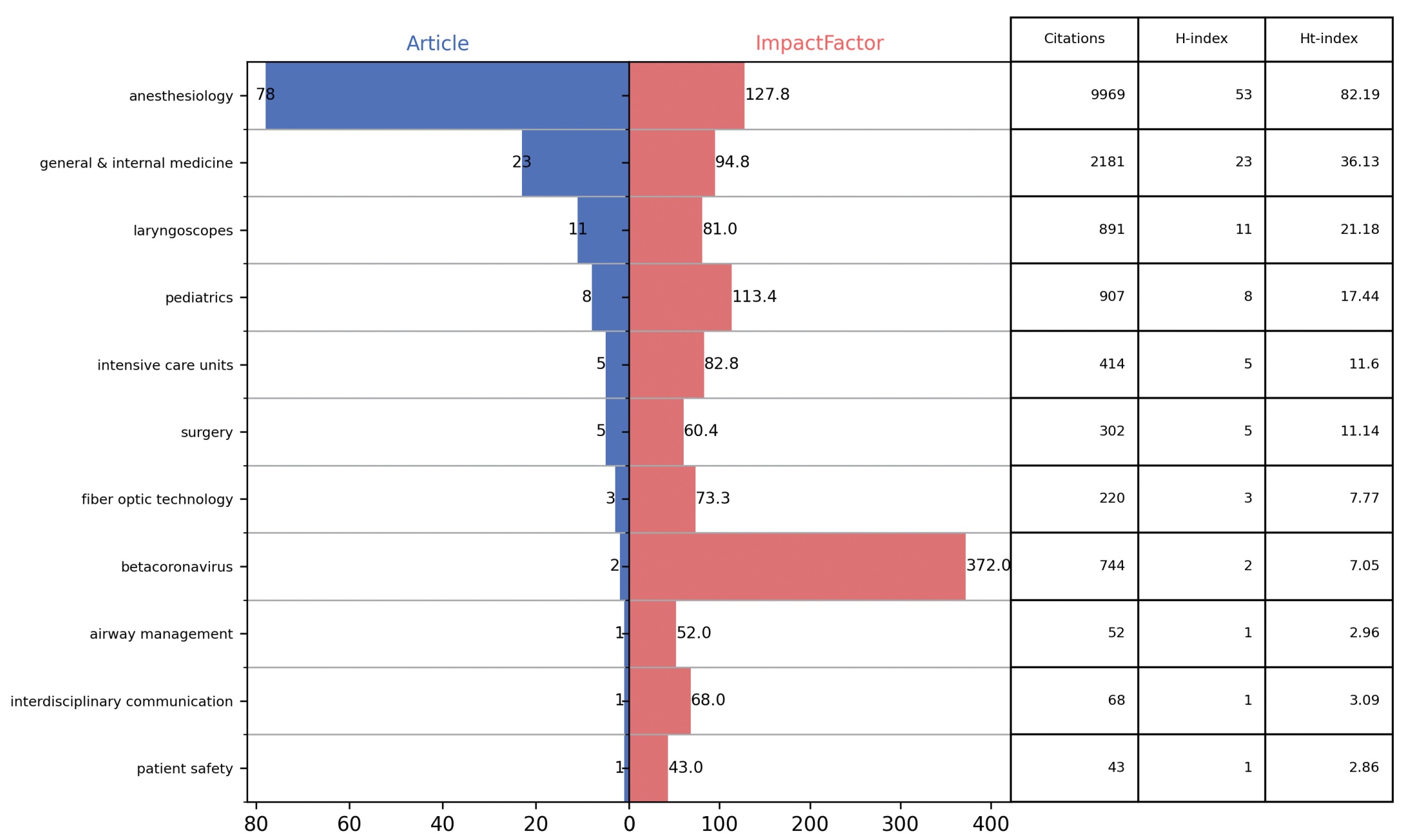
Download full-size image
The quantity of articles within each cluster term and their respective Impact Factors were visually represented by blue and red bars, respectively. The table on the right side of the display provided information on total citation counts, H-index values, and Ht-index.
Inferred Citation Counts of Top100DAM Derived From Cluster Terms
The mean citation count was computed based on the weighted frequency for cluster terms, MeSH terms, and WOS research areas (Tables A2–A4 in Appendix and equations (1)–(3)). In cluster terms, “anesthesiology” (=
In WOS research areas, the weighted frequencies were highest for “anesthesiology” (=
The inferred citation counts of each article were calculated and denoted as (4). The inferred citations derived from cluster terms had a significant correlation with actual citation counts (Pearson’s R = 0.06,
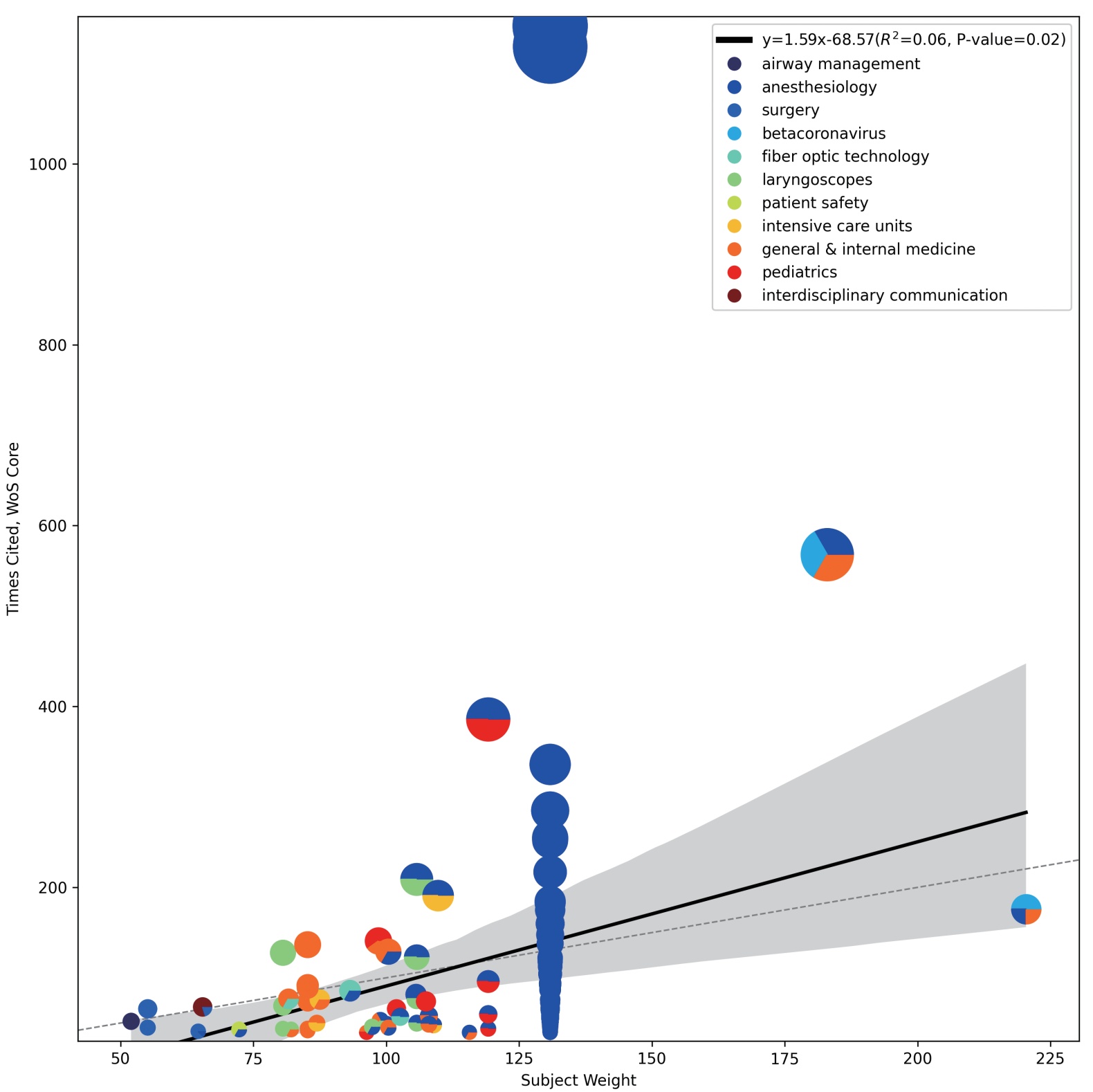
Download full-size image
Each point in the plot corresponds to an individual article. The colors, presented in a pie-chart-like manner, were employed to visually represent the proportion of each cluster term. A black line, accompanied by a transparent band, represented the regression line along with a 95% confidence interval. The gray dashed line running diagonally represented the line of equality (y = x).
Visual Representation of the Article Attributes Using a Sankey Diagram
According to the Sankey diagram (Figure A6 in Appendix), the majority of Top100DAM authors were from the US and England. Interestingly, authors from England tend to publish more frequently in
Generating Summaries for the Top100DAM Using MQE Software
We utilized the MQEsoftware v0.0.4 (Muen Biomedical and Optoelectronic Technologist, Inc., Taipei City, Taiwan) to compile a summary of DAM corresponding to each cluster term. Based on the summarized findings, a clear definition of difficult airway emerges. It is characterized as encountering challenges or outright failure in one or more stages of upper airway management and often requiring specialized skills from anesthesiologists.
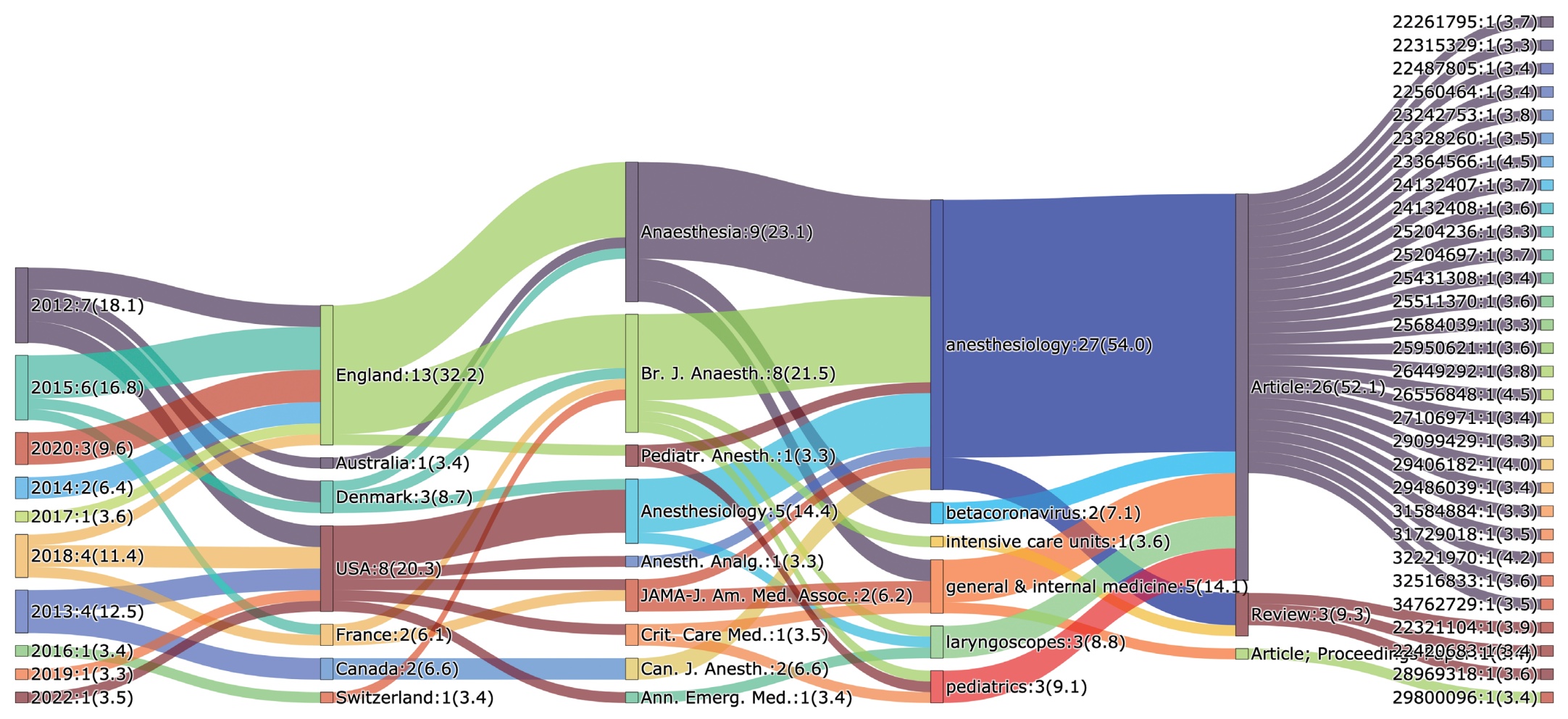
Download full-size image
The width of the bands connecting the two characteristics indicated the quantity of articles they shared. The number of articles was displayed alongside each characteristic, with Ht-index values provided within parentheses.
Temporal Trends in DAM Research
Our analysis revealed distinct shifts in research focus over the study period. From 2011 to 2015, studies predominantly centered on technique refinement and device comparisons. The period from 2016 to 2019 saw an increased emphasis on guideline development and implementation. From 2020 onwards, there was a notable surge in research addressing airway management in the context of infectious disease outbreaks, particularly COVID-19.
Discussion
In this study, we identified and analyzed the top 100 most-cited articles related to DAM from both PubMed and WOS databases. The contributors and research areas of these influential articles were carefully examined. Remarkably, one standout observation was the extraordinary IF associated with the cluster term “betacoronavirus”. This can be attributed to the sheer volume of citations originating from a select few articles at the height of global attention and expedited research commanded by the COVID-19 pandemic. This is consistent with the observed significant increase in publications in 2020 (Figure A7 in Appendix). All six of the highest-cited articles prominently featured the keyword “guideline” in their article titles (Table A5 in Appendix). This suggests a strong correlation between the guidelines and their impact on shaping the discourse surrounding DAM.
The top-cited article was published by
The second most cited article titled “Practice guidelines for the management of the difficult airway: an updated report by the American Society of Anesthesiologists Task Force on Management of the Difficult Airway” was published by
The third most cited article titled “Consensus guidelines for managing the airway in patients with COVID-19” was published by
Owing to distinctive anatomical and physiological characteristics, procedures such as mask ventilation, direct laryngoscopy, and endotracheal intubation pose relatively greater challenges when applied to the pediatric population.12 In response to the challenges posed by the COVID-19 pandemic, the Pediatric Difficult Intubation Collaborative advised the provision of supplemental oxygen and the utilization of videolaryngoscopy for anticipated DAM in pediatric patients, and direct laryngoscopy is not recommended in these cases.13
Another article within Top100DAM related to COVID-19 also published by
The prominence of guidelines and review articles among the most cited papers reflects their crucial role in synthesizing evidence and shaping clinical practice. While individual studies contribute new knowledge, these comprehensive works serve as reference points for clinicians and researchers alike, driving standardization of practices and identifying areas needing further investigation. This pattern underscores the importance of continually updating and refining guidelines to incorporate new evidence and technologies in the rapidly evolving field of difficult airway management.
In total, 7 articles fell under the cluster term “pediatric”. The first article, “A national emergency airway registry for children: landscape of tracheal intubation in 15 PICUs”,15 discussed the establishment of a nationwide registry to focus on how tracheal intubations performed in pediatric intensive care units (PICUs). Then, in “Development of a guideline for the management of the unanticipated difficult airway in pediatric practice”,16 the authors detailed their stepwise approach to formulate three guidelines to assist anesthetists in making a decision and education in challenging airways in children. They discovered that minimizing the number of intubation attempts is critical in pediatric patients. Meanwhile, in the study “Characterization of tracheal intubation process of care and safety outcomes in a tertiary pediatric critical care unit”,17 through a national registry adaptation, they delineated the variation in procedural processes and outcomes on tracheal intubations performed in a large PICU. The study “Pediatric airway management: current practices and future directions”18 investigated what is currently happening and what might happen in the future of pediatric airway management. The study “A retrospective audit of anesthetic techniques and difficulties in children with mucopolysaccharidoses”19 examined anesthesia techniques and incidences of complications in children with mucopolysaccharidoses, a rare genetic disorder. Finally, in the study “Cardiac arrests associated with tracheal intubations in PICUs: amulticenter cohort study”,20 they looked into risks associated with cardiac arrests associated with tracheal intubations in PICUs.
However, it is important to acknowledge several limitations associated with this approach. First, while citation count is often used to gauge a study’s impact and quality, it doesn’t always reflect the true influence or comprehensively capture the significance of the work. A highly-cited article does not necessarily equate to being the most influential in a given field. Second, our analysis is time-bound, meaning that newly published research may not be adequately represented due to insufficient time to accumulate citations. Third, there is a potential bias towards journals with larger readerships, which naturally attract more citations, leading to an overrepresentation of certain studies. Fourth, by focusing on highly cited articles, we may inadvertently overlook valuable research that hasn’t yet gained widespread recognition. Fifth, our analysis primarily considers citations from academic sources, potentially missing the broader impact in areas such as clinical practice, industry, or policy-making.
Despite these constraints, we have provided a comprehensive summary of significant DAM-related articles from the past decade. This study utilized advanced data visualization techniques, such as network visualization and Sankey diagrams, to analyze trends and connections between article features and citations. This approach simplifies the presentation of information compared to traditional methods using multiple tables. By leveraging artificial intelligence and NLP techniques, we efficiently captured DAM applications across various subject categories. Our concise summary aims to assist medical professionals in quickly identifying essential DAM-related articles. However, we recognize that our focus on highlycited articles may introduce publication bias, potentially skewing the representation of research within our analysis.
Conclusion
The combined bibliometric analysis, artificial intelligence, and NLP techniques to analyze Top100DAM articles provide a unique way to elucidate a decade’s landscape in research areas and interests. This study highlights the persistent challenges in DAM in the pediatric and adult population. Our analysis revealed a shift towards video laryngoscopy research, increased focus on guideline development, and recent emphasis on airway management during infectious disease outbreaks. These findings underscore the dynamic nature of DAM research and suggest areas for future investigation, including addressing implementation challenges of existing guidelines and developing context-specific protocols for diverse clinical settings. The increased publication volume and high citation rates during COVID-19 highlight how ongoing research and innovation accelerated through the pandemic, continuing to refine DAM practices. Articles with high citation rates mostly pertain to guidelines, illustrating their significant impact on clinical practice. This stresses the importance of a guideline-driven, systematic, and multidisciplinary approach. While our approach offers valuable insights, it is important to consider its limitations and to view this analysis as one of many tools for evaluating the significance of scientific work in the field of DAM.
References
| 1 |
Apfelbaum JL, Hagberg CA, Caplan RA, et al.
Practice guidelines for management of the difficult airway: an updated report by the American Society of Anesthesiologists Task Force on Management of the Difficult Airway.
Anesthesiology. 2013;118(2):251-270.
|
| 2 |
Casey JD, Semler MW, High K, Self WH.
How I manage a difficult intubation.
Critical Care. 2019;23(1):177.
|
| 3 |
Mosier JM, Joshi R, Hypes C, Pacheco G, Valenzuela T, Sakles JC.
The physiologically difficult airway.
West J Emerg Med. 2015;16(7):1109-1117.
|
| 4 |
Intensive Care Society State of the Art (SOA) 2022 Abstracts.
J Intensive Care Soc.
J Intensive Care Soc. 2023;24(1 Suppl):1-117.
|
| 5 |
Yang A, Kim D, Hwang PH, Lechner M.
Telemedicine and telementoring in rhinology, otology, and laryngology: ascoping review.
OTO Open. 2022;6(1):2473974X211072791.
|
| 6 |
Fruchterman TMJ, Reingold EM.
Graph drawing by force-directed placement.
Softw Pract Exp. 1991;
21(11):1129-1164. |
| 7 |
DataCamp.
Social Network Analysis & Mapping in Python with NetworkX.
|
| 8 |
Traag VA, Waltman L, van Eck NJ.
From Louvain to Leiden: guaranteeing well-connected communities.
Sci Rep. 2019;9(1):5233.
|
| 9 |
Chodrow PS, Veldt N, Benson AR.
Generative hypergraph clustering: from blockmodels to modularity.
Sci Adv. 2021;7(28):eabh1303.
|
| 10 |
Frerk C, Mitchell VS, McNarry AF, et al.
Difficult Airway Society 2015 guidelines for management of unanticipated difficult intubation in adults.
Br J Anaesth. 2015;115(6):827-848.
|
| 11 |
Cook TM, El-Boghdadly K, McGuire B, McNarry AF, Patel A, Higgs A.
Consensus guidelines for managing the airway in patients with COVID-19: Guidelines from the Difficult Airway Society, the Association of Anaesthetists the Intensive Care Society, the Faculty of Intensive Care Medicine and the Royal College of Anaesthetists.
Anaesthesia. 2020;75(6):785-799.
|
| 12 |
Krishna SG, Bryant JF, Tobias JD.
Management of the difficult airway in the pediatric patient.
J Pediatr Intensive Care. 2018;07:115-125.
|
| 13 |
Stein ML, Park RS, Afshari A, et al.
Lessons from COVID-19: a reflection on the strengths and weakness of early consensus recommendations for pediatric difficult airway management during a respiratory viral pandemic using a modified Delphi method.
Paediatr Anaesth. 2021;31(10).
|
| 14 |
El-Boghdadly K, Wong DJN, Owen R, et al.
Risks to healthcare workers following tracheal intubation of patients with COVID-19: a prospective international multicentre cohort study.
Anaesthesia. 2020;75(11):1437-1447.
|
| 15 |
Nishisaki A, Turner DA, Brown CAI, et al.
A National Emergency Airway Registry for children: landscape of tracheal intubation in 15 PICUs*.
Crit Care Med. 2013;41(3):874.
|
| 16 |
Black AE, Flynn PER, Smith HL, Thomas ML, Wilkinson KA; Association of Pediatric Anaesthetists of Great Britain and Ireland.
Development of a guideline for the management of the unanticipated difficult airway in pediatric practice.
Paediatr Anaesth. 2015;25(4):346-362.
|
| 17 |
Nishisaki A, Ferry S, Colborn S, et al.
Characterization of tracheal intubation process of care and safety outcomes in a tertiary pediatric intensive care unit.
Pediatr Crit Care Med. 2012;13(1):e5-e10.
|
| 18 |
Sunder RA, Haile DT, Farrell PT, Sharma A.
Pediatric airway management: current practices and future directions.
Paediatr Anaesth. 2012;22(10):1008-1015.
|
| 19 |
Frawley G, Fuenzalida D, Donath S, Yaplito-Lee J, Peters H.
A retrospective audit of anesthetic techniques and complications in children with mucopolysaccharidoses.
Paediatr Anaesth. 2012;22(8).
|
| 20 |
Shiima Y, Berg RA, Bogner HR, et al.
Cardiac arrests associated with tracheal intubations in PICUs: amulticenter cohort study.
Crit Care Med. 2016;44(9):1675-1682.
|
Appendix
https://drive.google.com/drive/folders/1jk7Wmh31XpCe-gpM7RslZb_OrVTVPIhu?usp=drive_link
TOP


